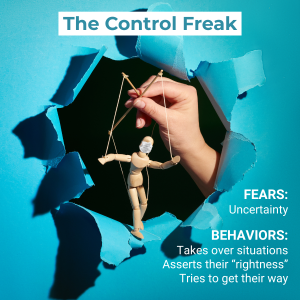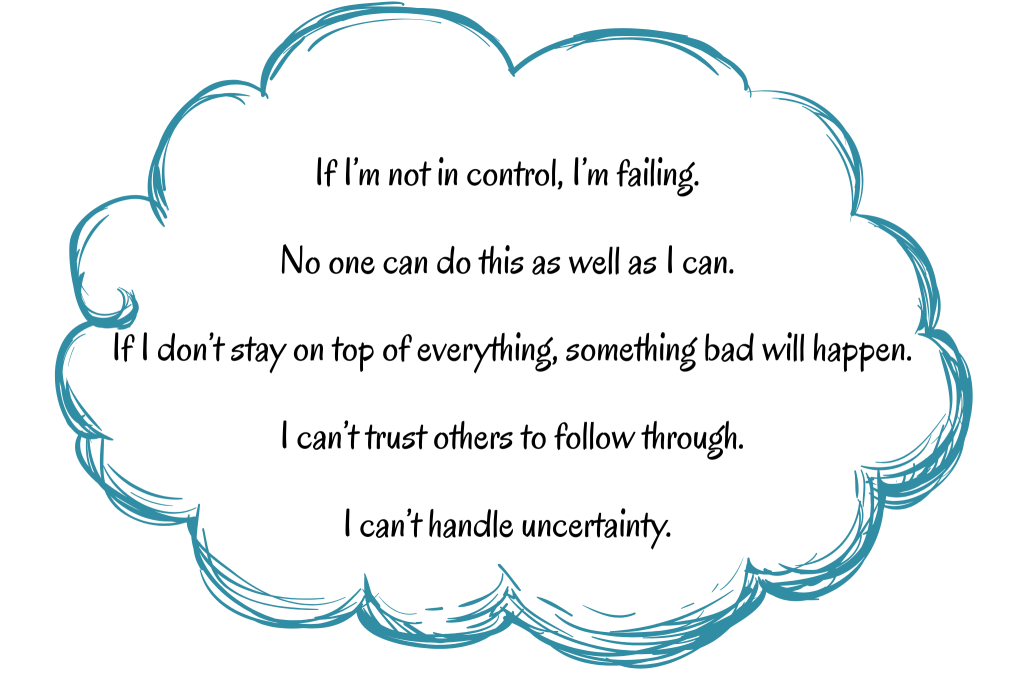The Control Freak is typically not driven by arrogance, but by a deep-seated fear—a profound discomfort with uncertainty and a belief that safety and success hinge on their ability to maintain control. While they may project an image of confidence, decisiveness, and drive, beneath the surface lies anxiety, frustration, and the overwhelming burden of believing that everything rests on their shoulders.
In our study, nearly one in four leaders (23%) fall victim to the Control Freak Faulty Program, becoming trapped in the Stuckness Zone™. These leaders, operating in a world characterized by volatility, uncertainty, complexity, and ambiguity (VUCA), struggle to accept that not everything can be controlled. They respond to unpredictability by tightening their grip, convinced that maintaining control will prevent disastrous consequences.
Most leaders describe a strong sense that being in control and ensuring things are done “the right way” can somehow prevent bad things from happening. As a result, they end up controlling everything from schedules to work products to conversations. Some leaders with this programming also use control as a path to perfectionism to avoid judgment and failure.
This article is part of our Faulty Programs series. If you’re new here, start with our opener—“Why Leaders Get Stuck: The Stuckness Zone™ and Faulty Programs.” It lays the groundwork for what Faulty Programs are, how they form, and why upgrading them is essential for future-ready leadership.
How the Control Freak Faulty Program Shows Up
The Control Freak program shows up as a deep-seated need to be in charge and ensure things happen “the right way.” It’s the voice that says, “If I’m not in control, everything will fall apart.”
It can sound or look like:
- “It’s my responsibility to make sure things happen the way they should.”
- “I’m the only one who knows how to do this the right way.”
- “If I don’t step in, this will fail.”
- “My way is the best—or only—way.”
Behaviorally, it often shows up as:
- Taking over situations and projects, even when others are capable.
- Overriding others’ ideas or decisions to ensure things go “right.”
- Micromanaging or hovering to prevent mistakes.
- Feeling impatient or anxious when outcomes aren’t predictable.
- Hijacking or controlling meetings and conversations.
At its core, the Control Freak program is a misguided attempt to create certainty in an uncertain world. While it may offer temporary relief, it ultimately limits others’ growth—and drains the leader’s own capacity for calm and trust.

The Fears Driving the Control Freak
The Control Freak is rooted in a deep fear of uncertainty, loss, and failure. Leaders who run this program often developed it early in life when being in control was linked to safety, approval, or survival.
Common fears include:
- Fear of chaos or things “going wrong.”
- Fear of being blindsided or unprepared.
- Fear of others’ incompetence reflecting poorly on them.
- Fear that if they loosen their grip, they’ll lose relevance or respect.
When the Control Freak is in the driver’s seat, the head trash sounds like:
- “If I don’t stay on top of everything, something bad will happen.”
- “No one can do this as well as I can.”
- “I can’t trust others to follow through.”
- “If I’m not in control, I’m failing.”
- “If I ensure things happen ‘the right way,’ I can prevent bad things from happening; it’s my responsibility.”
- “I can’t handle uncertainty.”
This faulty wiring pushes leaders to over-own results that aren’t theirs to carry—causing unnecessary stress, damaged relationships, and a perpetual sense of pressure.
The Costs of the Control Freak
For Leaders
The Control Freak takes a heavy toll on well-being. Leaders running this program often report chronic stress, exhaustion, and frustration. They struggle to delegate, rest, or disconnect—believing that their constant oversight keeps things afloat. Over time, it leads to burnout and resentment.
- Constant tension and worry about what might go wrong.
- Difficulty trusting others and relinquishing control.
- Burnout from overwork and over-responsibility.
- Emotional reactivity and strained relationships.
For Organizations
When leaders over-control, teams disengage. People feel micromanaged, distrusted, or hesitant to take ownership. Innovation stalls because there’s no space for experimentation or shared learning. The culture shifts from empowerment to compliance.
- Reduced innovation and risk-taking.
- Lower trust and psychological safety.
- Bottlenecks in decision-making.
- Talent disengagement and turnover.
Ultimately, control kills collaboration—and limits the growth leaders are trying so hard to protect.
Want to dig deeper? Download our free research paper, Future-Proofing Leadership: What It Takes to Thrive Amidst Change and Disruption, to explore the findings from our study of 250 leaders across industries.
Where Leaders Get Stuck (Our Data)
Our analysis found that the Control Freak program most often sabotages leaders in these adaptive change areas:
- Emotional Regulation (35%) – The biggest area where Control Freak leaders find themselves challenged is their mindsets that allow them to pause, be curious, practice patience and understanding, and respond in a more neutral manner—especially when things don’t go as planned. Our analysis showed that 35 percent of leaders running this faulty program want to improve their ability to regulate their emotions, but frequently get sucked into the reactive trap.
- Listening Fully (24%) – Almost one quarter (24 percent) of leader running the Control Freak program want to improve, but struggle, with listening fully; this includes being fully present rather than distracted when with others, holding space for connection and for people to feel valued and heard—even if they don’t agree with them—and listening to understand versus listening to reply. This is especially challenging when others disagree or approach things differently.
- Growth Feedback (22%) – It might seem easy for leaders running the Control Freak program to have growth-feedback conversations. After all, they’re not usually worried about upsetting other people. However, 22 percent of the leaders in our analysis running this faulty program struggle in this area. Where they typically get stuck is having the conversations clearly—or at all. Instead of creating learning moments, they end up taking over and do not create opportunities for others, or they presume it’s easier or more effective if they just do things or fix them to be “right” according to their definition.
- Setting Boundaries (20%) – For leaders who feel they are responsible for ensuring things go a certain way and are trying to eliminate uncertainty in their world, it’s not surprising that just over 20 percent of leaders running the Control Freak struggle with setting and honoring healthy boundaries. When jumping in to fix, take over, or own things that aren’t necessarily theirs to own is instinctive, it’s hard to back off, say no, and create space for others to step up to avoid being overscheduled. This is also an area where leaders tend to struggle at home, taking over projects and chores because they don’t feel others in their household can do them right, and then they are overloaded with to-do lists.
Interestingly, an overwhelming 72 percent of leaders running the Control Freak program have mindset-related improvement goals as a top priority. It makes sense because an incredible amount of self-regulation is required when the brain has an overactive need to control people and situations—a sign that upgrading this program is more about rewiring beliefs than adding skills.
Why We Get in Our Own Way
Most Control Freak leaders learned early on that being in control equaled safety. Whether it came from unpredictable family dynamics, illness, or conditional approval, control became a shield against uncertainty.
Like Therese—a leader who learned through childhood trauma and illness that control could literally mean survival—many leaders internalize the message: “If I don’t manage everything, something terrible will happen.”
These beliefs, once protective, now keep leaders overextended, anxious, and disconnected from others. The irony? In trying to prevent failure, they often prevent growth—for themselves and their teams.
Breaking Free: The Upgrade Process
Upgrading the Control Freak program isn’t about becoming passive—it’s about learning to trust, delegate, and let others contribute without needing to control the outcome.
1. Name It
Notice when your Control Freak voice shows up and call it out.
“I see you, Control Freak. You’re trying to keep me safe, but I don’t need to control everything anymore.”
2. Own It
Map your personal expression and origin.
- Expression: When do you tend to take over, interrupt, or correct others? Where do you believe your way is “the right way”?
- Origin: What early experiences taught you that control equals safety or that it’s your responsibility to make sure things happen the “right way”?
Acknowledge that this program once helped you—but it’s not serving you now. Gratitude softens shame.
“This program helped me survive uncertainty—but I’m ready to lead differently.”
3. Challenge It (Upgrade)
Rewrite the script with targeted experiments.
Replace the head trash. Swap it with new short, sticky truths (belief will eventually set in with practice):

Run micro-experiments.
Collect data that slowly disproves the lies the Control Freak has sold you.
- Gather feedback: Ask people who know you well the following question: “What do you experience when I try to control things?” (The feedback likely will sting if people are being honest – and that’s the point. When you hear the costs – even if you intuitively know them – it frequently leads to a moment of pause the next time your control instincts want to take over.)
- Practice Mini Delegation: Let someone else take ownership of pieces of a project—and resist the urge to “fix” it. Tee it up as a learning and growth opportunity for both of you.
- Hold Space for Others: Stay silent and curious in meetings instead of asserting your viewpoint.
- Practice pausing before reacting—especially when things don’t go your way.
Because the Control Freak program is driven by a deep fear of uncertainty and an attachment to having things done a specific way, the key to challenging and upgrading it lies in confronting the discomfort head-on. You have to help your brain recognize the hidden costs of this well-intentioned need to control—how it strains relationships, stifles collaboration, and limits growth. When you can see those costs clearly, it becomes easier to loosen your grip, reduce controlling impulses, and release the assumption that your way is the only right way.
Steps You Can Take
✅ Say out loud: “Control is an illusion—and I’m okay with that.”
✅ Delegate one thing without monitoring it.
✅ Pause before jumping in—ask, “What’s my real fear here?”
✅ Celebrate someone else’s way of doing things, even if it’s not your way.
Each time you resist the urge to take over and the world doesn’t fall apart, you weaken the Control Freak’s hold.
Moving Beyond the Control Freak
When leaders let go of the need to control, they create space for possibility. They shift from commanding to co-creating, from managing outcomes to mobilizing others. Spend time visualizing what your life would be like if the Control Freak program were no longer in the driver’s seat in your life.
As one leader put it after upgrading this program: “When I stopped trying to control everything, I finally found peace—and so did my team.”
Want help identifying and moving beyond your Faulty Programs? Our Courageous Leadership Program helps people identify their Faulty Programs like the Control Freak, rewrite limiting stories, and build systems and habits that enable sustainable, scalable performance.
What’s Next in This Series
This article is part of our ongoing series unpacking the Faulty Programs that keep leaders stuck in the Stuckness Zone™.
In the next installment, we’ll explore The Mime—why continually keeping the peace and self-silencing is a disservice to yourself and others.
Our aim is simple: normalize the messiness of being human, expose the invisible patterns holding leaders back, and provide actionable paths to help you—and your organization—thrive in a disruptive world.
Stay HUMAN. Stay connected. Stay safe. Show Up as a Leader.







